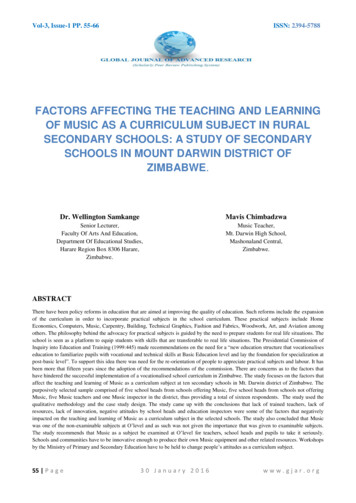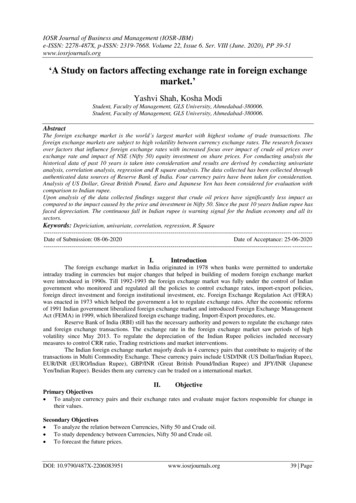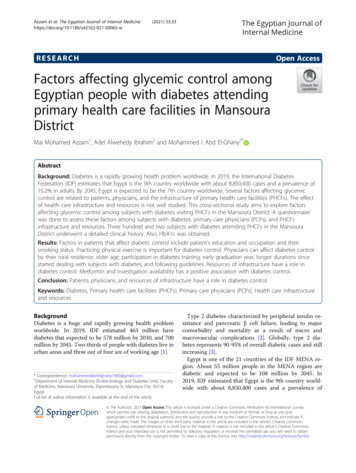
Transcription
Azzam et al. The Egyptian Journal of Internal (2021) 33:33The Egyptian Journal ofInternal MedicineRESEARCHOpen AccessFactors affecting glycemic control amongEgyptian people with diabetes attendingprimary health care facilities in MansouraDistrictMai Mohamed Azzam1, Adel Alwehedy Ibrahim2 and Mohammed I. Abd El-Ghany3*AbstractBackground: Diabetes is a rapidly growing health problem worldwide. In 2019, the International DiabetesFederation (IDF) estimates that Egypt is the 9th country worldwide with about 8,850,400 cases and a prevalence of15.2% in adults. By 2045, Egypt is expected to be the 7th country worldwide. Several factors affecting glycemiccontrol are related to patients, physicians, and the infrastructure of primary health care facilities (PHCFs). The effectof health care infrastructure and resources is not well studied. This cross-sectional study aims to explore factorsaffecting glycemic control among subjects with diabetes visiting PHCFs in the Mansoura District. A questionnairewas done to assess these factors among subjects with diabetes, primary care physicians (PCPs), and PHCFsinfrastructure and resources. Three hundred and two subjects with diabetes attending PHCFs in the MansouraDistrict underwent a detailed clinical history. Also, HbA1c was obtained.Results: Factors in patients that affect diabetic control include patient’s education and occupation and theirsmoking status. Practicing physical exercise is important for diabetes control. Physicians can affect diabetes controlby their rural residence, older age, participation in diabetes training, early graduation year, longer durations sincestarted dealing with subjects with diabetes, and following guidelines. Resources of infrastructure have a role indiabetes control. Metformin and investigation availability has a positive association with diabetes control.Conclusion: Patients, physicians, and resources of infrastructure have a role in diabetes control.Keywords: Diabetes, Primary health care facilities (PHCFs), Primary care physicians (PCPs), Health care infrastructureand resourcesBackgroundDiabetes is a huge and rapidly growing health problemworldwide. In 2019, IDF estimated 463 million havediabetes that expected to be 578 million by 2030, and 700million by 2045. Two-thirds of people with diabetes live inurban areas and three out of four are of working age [1].* Correspondence: mohammedabdelghany1983@gmail.com3Department of Internal Medicine (Endocrinology and Diabetes Unit), Facultyof Medicine, Mansoura University, Elgomhouria St, Mansoura City 35516,EgyptFull list of author information is available at the end of the articleType 2 diabetes characterized by peripheral insulin resistance and pancreatic β cell failure, leading to majorcomorbidity and mortality as a result of micro andmacrovascular complications [2]. Globally, type 2 diabetes represents 90-95% of overall diabetic cases and stillincreasing [3].Egypt is one of the 21 countries of the IDF MENA region. About 55 million people in the MENA region arediabetic and expected to be 108 million by 2045. In2019, IDF estimated that Egypt is the 9th country worldwide with about 8,850,400 cases and a prevalence of The Author(s). 2021 Open Access This article is licensed under a Creative Commons Attribution 4.0 International License,which permits use, sharing, adaptation, distribution and reproduction in any medium or format, as long as you giveappropriate credit to the original author(s) and the source, provide a link to the Creative Commons licence, and indicate ifchanges were made. The images or other third party material in this article are included in the article's Creative Commonslicence, unless indicated otherwise in a credit line to the material. If material is not included in the article's Creative Commonslicence and your intended use is not permitted by statutory regulation or exceeds the permitted use, you will need to obtainpermission directly from the copyright holder. To view a copy of this licence, visit http://creativecommons.org/licenses/by/4.0/.
Azzam et al. The Egyptian Journal of Internal Medicine(2021) 33:3315.2% in adults. By 2045, Egypt expected to be the 7thcountry worldwide [1].For all subjects with diabetes, the main therapeuticgoal is maintaining good glycemic control to preventmicro and macrovascular complications. However, themajority of them failed to achieve good glycemic controland the reasons for this poor glycemic control are multifactorial and complex [4].The effectiveness of diabetes management is mainlybased on patient compliance with medications andrecommendations; thus, patient education is essential forproper diabetes management. The patient needs tounderstand the importance of a healthy diet, exercisepracticing, smoking and alcohol cessation, medicationadherence, foot hygiene, suitable footwear, periodicevaluation of glycemic control, and occurrence and progression of any complication [5].Ahmad et al. reported that the four variables affectingthe outcome of glycemic control were patient age, diabetes duration, drug utilization pattern, and adherence.As a short diabetes duration, monotherapy and gooddrug adherence impact the achievement of good glycemiccontrol [6].People with diabetes require access to continuous, systematic, and organized care by skilled medical personnel.Outcomes could undergo improvement at the primarycare level with basic interventions including medications,education, counseling, and continuous follow-up. Suchorganized care must include a periodic evaluation of glycemic control and complications, agreed and updatedcare plan, and access to person-centered care deliveredby a multidisciplinary team [5].Diabetes care is an important component in PHCwithin the society. Community care of diabetes dependsmainly on health knowledge, education, and communication which are extremely efficient and cost-effective.Using health education like a PHC tool shown to reducerisk, prevent or delay the onset of major diabetic complications [7].Primary care physicians (PCPs) are at the forefront ofdiabetes care as most people attend PHCFs firstly, especially in low-income countries where these services are illequipped to address the rising demand and have a shortage of specialists. Thus, PCPs should be well qualified togive optimal diabetes care to prevent complications andimprove the quality of life of affected subjects [8].The greatest challenge is that diabetes managementnecessitates many processes and decisions involvingphysicians and patients. Despite the technical advances in diabetes management, diabetes care is still,the most complex chronic illness to be treated at thePHC level [9].To our knowledge, there is little research done on thecontrol of diabetes and factors affecting it at PHCFs inPage 2 of 10our locality. And most studies done did not include theeffect of health care infrastructure and resources on glycemic control. So, we are directing our research to studythis.Patients and methodsPatientsThis cross-sectional study includes 302 subjects withdiabetes visiting 24 PHCFs in Mansoura District duringthe period from March 2019 to March 2020 after the approval of the Mansoura Faculty of Medicine InstitutionalResearch Board (MFM-IRB). Agreement to participate inthe study by informed written consent was approved bythe local ethical committee at the Mansoura Faculty ofMedicine. Any participant who refused to contribute tothe study was excluded.MethodsIn Mansoura District, there are 54 PHCFs, but in ourstudy, we visited 24 facilities, 6 urban and 18 ruralchosen by simple random sample. In each facility, wefilled 3 questionnaires, one for infrastructure, one forphysicians responsible for subjects with diabetes in thefacility, and one for subjects with diabetes visiting the facility for any reason either to follow up diabetes or anyother cause. Health care infrastructure questionnaire includesinformation about available drugs, are they availableall the time or not, available investigations, are theyavailable all the time or not, time of result ofinvestigation either on the same day or another day,is their referral system or not, is there availablehealth education (HE) material or not and if thefacility uses special registration forms for diabeticsor not. Physician questionnaire includes information aboutage, residence, gender, graduation year, durationsince dealing with diabetic patients, specialization,participate in training for diabetes mellitus or not,follow guidelines usually, sometimes or never, dohealth education usually, sometimes, or never, docomplete or incomplete system examination, and dofoot examination or not. Patient questionnaire includes information aboutpersonal history as age, gender, occupation,residence, education, social status, and special habit.Present history as duration of diabetes, recenttreatment, medication adherence, associateddiseases, exercise, diet, follow-up, foot care, cause ofvisit, symptoms of high or low blood glucose orinfection in the last 2 weeks, and family support.History of hospitalization in the last 12 months andfamily history of diabetes.
Azzam et al. The Egyptian Journal of Internal Medicine(2021) 33:33All participants were subjected to anthropometricmeasurements (weight, height, and BMI), and completeclinical examination with specific reference to any microor macrovascular complications.SamplingA 5-ml venous blood sample was collected from eachsubject on K2EDTA tubes via proper venipuncture technique under complete aseptic condition. Samples weresent to the lab of the faculty of medicine to be examinedfor glycosylated hemoglobin (HbA1c) that was measuredby the ion-exchange chromatography method (BiosystemCo., Spain).Statistical analysisCollected data was coded, computed, and statisticallyanalyzed using SPSS version 16. The data presented intables and figures. Qualitative variables were presentedas frequency and percentage while continuous quantitativevariables were presented as mean SD. For comparisonof qualitative data, chi-square (χ2) was used, which is replaced by Monte Carlo exact probability if the value ofany expected cell was less than 5. Binary regression wasused to detect the prediction of factors affecting glycemiccontrol. The difference was considered significant at ap value 0.05.Results**Un-tabulated dataDemographic data of subjectsThe age of most of our participants was 40-60 years old(67.9%); with medians of age were 52 years. Most ofthem were females (78.8%), from rural areas (71.9%),married (72.8%), with basic or no education (47.4%), andhousewives (46.4%). Most of our participants neversmoked (85.8%). Among smoker subjects (66.7%) werecigarette smokers. Physical exercise was not practiced inmost of the subjects (62.3%).Most of the participants had a positive family historyof diabetes (84.1%), and 183 participants (72%) were offirst-degree relatives. Most of the subjects visitingprimary health centers because these facilities were nearplaces for measuring blood sugar (55%).Only 15.6% of studied subjects were hospitalized inthe last year, 76.6% of them were hospitalized one time.Most of the subjects (47.5%) were hospitalized becauseof operations and 41.1% due to diabetes complications.Duration of diabetes and type of treatmentAbout one-third of the participants (30.8%) having diabetes for less than 5 years. The percentage of subjectstaking oral hypoglycemic agents (60%) was higher thanthe percentage of subjects taking metformin (55%) orPage 3 of 10insulin (35.8%), and 103 subjects (34.1%) were takingoral hypoglycemic and metformin together.In our study, 108 subjects were taking insulin, 62 subjects were taking insulin only, 36 subjects were taking insulin and metformin, 6 subjects were taking insulin withoral hypoglycemic drugs and metformin, and 4 subjectsonly were taking insulin with oral hypoglycemic drugs.Most of the subjects were taking mixed insulin 70/30(97.2%). Only 4 subjects were taking glargine insulin atnight. Most of the subjects were taking insulin beforebreakfast and dinner (63.9%). Most of the subjects wereinjecting insulin in the arm and thigh (26.9%).Most of the subjects had no follow-up schedule andvisited doctors only on demand. Medium medication adherence was found in 51.3% of subjects, high adherencein 30.5% and low adherence in only 18.2%.Infrastructure characteristics of the studied PHCFsThree-quarters of visited PHCFs were in rural areas(75%). All of them did not have insulin but had oralhypoglycemic drugs. Nineteen facilities only had metformin (79.2%). In most of the facilities (62.5%), medicationswere available all the time. Most of the facilities had fasting blood glucose (FBG) and random blood glucose (RBG)investigations (95.8%), while most of them had no lipidsor complete blood count (CBC) investigations (83.3-79.2%respectively), and all of them had hemoglobin (HB) investigations. In most of the facilities, investigations availableall the time (83.3%), and in all of them, the results of theinvestigations were taken on the same day. In most of thefacilities, there was no referral (66.7%), no available healtheducation materials (95.8%), and there were special registration forms for diabetes (66.7%).Physicians’ characteristics of the PHCFsMore than one-half of the physicians were from ruralareas (55.9%), were females (82.4%), and aged from 3040 years old (47.1%). More than half (55.9%) were general practitioners, while 26.5% had fellowship and 17.6%had a master’s degree. In total, 52.9% participated intraining of diabetic care. Nearly one-half of the physicians (44.1%) have been dealing with subjects having diabetes for less than 5 years. Fifty percent of physiciansusually follow guidelines while 47.1% of them sometimesfollow guidelines, and only one physician does notfollow guidelines. Most of them usually do healtheducation, foot examination but incomplete systematicexamination.**Tabulated dataRelationship between controlled blood glucose and somefactors of the studied subjectsTable 1 shows that the percentage of glycemic controlwas higher among younger age subjects ( 40 years),
(2021) 33:33Azzam et al. The Egyptian Journal of Internal MedicinePage 4 of 10Table 1 Relationship between controlled blood glucose and some factors of the studied subjectsFactorsTotalControlled HbA1c 7Uncontrolled HbA1c 7No.%No.%POR (95% CI)RegressionAOR (95% CI)Age (years) 40281346.41553.640 2047134.813365.20.2301.62 (0.73-3.60)60 702231.44868.60.1621.89 6.40.2812.80 9High402460.01640.0Secondary1193831.981Basic or less1434430.899rGenderrResidencer0.8233.51 (2.07-5.95)68.10.0023.20 (1.52-6.71)0.27 (0.13-0.57)69.2 0.0011.03 (0.52-2.04)0.24 (0.11-0.51)0.5481.18 (0.69-1.99)EducationrSocial .9Never 0.44 (0.18-1.07)Current smokers21419.01781.00.1432.26 0.0726.14 (0.66-56.8)No1885931.412968.60.0228.75 032.510467.5 10 year1214537.27662.8 10 32.24267.8rSmokingr2.25 (0.94-5.48)Practicing physical ex.rFamily historyr0.2981.40 (0.74-2.62)0.1771.41 (0.86-2.31)Associated diseasesrHospitalization in last y.r0.8891.07 (0.55-2.04)0.3281.27 (0.78-2.03)Family supportrDuration since starting tttr0.5340.47 (0.29-0.76)0.3641.32 (0.72-2.13)Treatmentr3.66 (1.21-8.46)
(2021) 33:33Azzam et al. The Egyptian Journal of Internal MedicinePage 5 of 10Table 1 Relationship between controlled blood glucose and some factors of the studied subjects (Continued)Controlled HbA1c 7Uncontrolled HbA1c 5233.510366.50.2211.39 (0.82-2.37)Low551629.13970.90.1371.72 73.30.0503.09 (0.99-9.62)Obese2137836.713563.40.1961.98 (0.69-5.66)FactorsOHG insulinTotalPOR (95% CI)0.0612.01 (0.96-4.19)RegressionAOR (95% CI)Medication adherencerBMImales, from rural areas, highly educated, and not married.Also, the percentage of glycemic control was higheramong never smoked and ex-smoker subjects in comparison to currently smoker subjects. Also, it was higheramong subjects practicing physical exercises, with negativefamily history of diabetes, had no associated chronic diseases, not hospitalized in last year, had family support,started treatment at an older age ( 40 years), receivedoral hypoglycemic drugs, having high medicationadherence and with average BMI. The level of significance(P 0.05) was present with three factors: education,practicing physical exercises, and BMI. Lower level ofeducation, current smoking, and non-practicing physicalexercises were the most factors predicting uncontrolledglycemic level, as adjusted odd’s ratio (AOR) at 95.0% CIfor them were 3.20. 1.03, 2.25, and 3.66 respectively.Distribution of the studied subjects according blood glucosecontrol and its relation to PHCFs infrastructure factorsAs shown in Table 2, the percentage of glycemic controlwas higher among subjects who received care at PHCFsin rural areas, where metformin was available, metformin was available all the time, available investigation forFBG, RBG, lipids, CBC, HB, and other investigations.Also, it is higher where, these investigations were available all the time, a referral system was used, availableHE materials, and using special registration form for diabetic patients. The significance level (P 0.05) waspresent with three factors: available of metformin, available lipids, and other investigations. Availability of otherinvestigations was the factor predicting controlled glycemic level, as adjusted odd’s ratio (AOR) at 95.0% CIwas 0.465 (0.283-0.764).Distribution of the studied subjects according blood glucosecontrol and its relation to PCPs factorsAs shown in Table 3, the percentage of glycemic controlwas higher among subjects received care by physiciancharacterized by living in rural areas, males, older age ( r40 years), graduated early, had a master degree, participated in diabetes training, started dealing with diabeticpatients since 5 years, follow guidelines, doing HE,doing complete systematic examination, and doing footexamination. The significance level (P 0.05) waspresent in the following physicians’ related factors: residence in rural areas, older age, early graduation, participated in diabetes training, dealing with diabetic patientsfor a longer period, and following guidelines. Older ageof physician ( 40 years) and following guidelines ingiving care to diabetic patients were the most factorspredicting uncontrolled glycemic level, as adjusted odd’sratio (AOR) at 95.0% CI for both were 1.64 (1.00-2.70)and 2.66 (1.64-4.33) respectively.DiscussionIn Egypt, there is no yearly routine checkup policy orscreening program for chronic noncommunicable illnesses [10]. People with diabetes usually visit governmental health care centers to get medications for free orfor a little cost, but not for periodic examination [11].In our current study, 24 PHCFs were evaluated, 6urban (25%), and 18 rural (75%) for their infrastructurecharacteristics and their impact on the glycemic controlof subjects attending these facilities.We reported that oral hypoglycemic agents were foundin all facilities (100%), while insulin was not found in allof them (100%). Metformin was not found in 5 facilities(20.8%); also, medications were not found all-time at 9facilities (37.5%). FBG and RBG tests were found in allPHCFs except one (4.2%). Lipid investigations werefound in 4 facilities (16.7%), also CBC tests were foundonly in 5 facilities (20.8%). The investigations were foundall the time at 20 facilities (83.3%), and the results wereobtained on the same day in all 24 facilities (100%). Only8 facilities (33.3%) make referrals for complicated cases.The health education material was found in just one facility (4.2%), and the usage of special registration formswas found in 16 facilities (66.7%).
Azzam et al. The Egyptian Journal of Internal Medicine(2021) 33:33Page 6 of 10Table 2 Distribution of the studied subjects according blood glucose control and its relation to PHCFs infrastructure factorsFactorsTotalControlled HbA1c 7Uncontrolled HbA1c 7No.%No.POR (95% CI)0.5590.85 (0.51-1.45)%RegressionAOR (95% 9436.216663.8No421228.63072.4Same day302106100.196100.Other .0No882933.05967.0rMetformin availabilityr0.0472.36 (1.00-5.60)0.2481.34 (0.81-2.21)Metformin available all timerAvailable FBG/RBGr0.6021.37 (0.42-4.48)0.0052.04 (1.24-3.36)Available lipidsrAvailable CBCr0.2751.33 (0.80-2.22)Available HBAvailable other investigationr0.0022.15 (1.31-3.53)0.3391.41 (0.69-2.90)0.7831.07 (0.66-1.73)0.47 (0.28-0.76)Available investigation all the timerTime of investigation resultsReferralrAvailable HE materialsr0.1211.70 (0.86-3.36)0.6171.14 (0.68-1.73)Use special registration formIn our study, we found the percentage of glycemiccontrol was higher among subjects who received care atPHCFs in rural areas, where metformin was available,metformin was available all the time, availablerinvestigation for FBG, RBG, lipids, CBC, HB, and otherinvestigations. Also, it is higher where, these investigations were available all the time, a referral system wasused, available health education materials, and using
(2021) 33:33Azzam et al. The Egyptian Journal of Internal MedicinePage 7 of 10Table 3 Distribution of the studied subjects according blood glucose control and its relation to PCPs factorsPhysician’s factorsTotalControlled HbA1c 7Uncontrolled HbA1c 7No.%No.%POR (95% CI)RegressionAOR (95% CI)Physician’s Males542037.03463.0Females2488634.716265.3 401315743.57456.5 401714928.712271.3 20001988241.411658.6 72136.83663.40.4261.32 (0.66-2.63)GP1604830.011270.00.0341.79 (1.04-3.11)Yes1496342.38657.7No1534328.111071.9 5 years1867540.311159.7 5 232.111067.9Done2499337.315662.7Not done531324.54075.5r0.0052.02 (1.23-3.31)Physician’s genderr0.7421.11 (0.60-2.04)Physician’s ager0.0071.92 (1.19-3.10)1.64 (1.00-2.70)Physician’s graduater0.0022.36 (1.38-4.03)SpecialtyrParticipate in DM trainingr0.0091.86 (1.16-3.03)Duration since dealingwith DM patientsr0.0161.85 (1.12-3.07)Follow guidelinesr 0.0012.66 (1.63-4.33)2.66 (1.64-4.33)Doing HEr0.6891.14 (0.60-2.15)Do systemic examinationr0.2401.33 (0.83-2.13)Doing foot examspecial registration form for diabetic patients. The significance level (P 0.05) was present with three factors: available of metformin, available lipids, and otherinvestigations. Availability of other investigations wasthe factor predicting controlled glycemic level, as adjusted odd’s ratio (AOR) at 95.0% CI was 0.465 (0.2830.764).A study done by Assunção et al. to recognize factorsassociated with poor glycemic control in subjects withr0.0761.83 (0.93-3.61)diabetes seen at 32 primary health care centers in southern Brazil that included 372 subjects. They described theinfrastructures in their study and stated that 37 subjectsfollowed the diabetes patient care program. Subjectswho had followed the available schedules in the PHCwere 48.7%. Capillary glycemia measuring bands wereavailable for 16.1% of the subjects. Also, they stated thatsubjects on oral hypoglycemic agents (n 246) 63.0%and insulin (n 40) 57.5% attended visits where such
Azzam et al. The Egyptian Journal of Internal Medicine(2021) 33:33drugs were regularly available. Special records for subjects with diabetes were available for 21% of them. Educational material was available for 35.5% of subjects [9].In our current study, 34 physicians gave the care forsubjects with diabetes in the 24 PHCFs, 6 males (17.6%)and 28 females (82.4%). Most of them were from ruralareas (55.9%); most of them were aged from 30 to 40years (47.1%). Also, most of them were general practitioners (55.9%). Physicians usually followed the guidelines were 50% and 47.1% sometimes followed theguidelines. A lot of them (85.3%) do health education tothe subjects, and 85.3% do foot examination while examining the subjects. Most of the physicians (44.1%) dealing with subjects having diabetes for less than 5 years.As matched by a study done by Assunção et al.reported that subjects with diabetes were seen by 58physicians, and 52% of the subjects were treated by nonspecialists or general practitioners. Approximately 80%of the subjects were examined by physicians who workedat health centers for more than a year. Most of the physicians were females (65%) [9].A study done by Ciccone et al. aimed at a projectnamed Leonardo Project. This project showed the feasibility of incorporating care managers (specially trainednurses) into the health care system to support generalpractitioners and specialists in the treatment of subjectswith diabetes. In this project, care managers workeddirectly with patients, helping them to change lifestyles,monitoring their conditions, offering the required information, improve self-care skills, and achieve better compliance with care recommendations. This model resultedin a tangible improvement in the clinical parameters ofthe enrolled subjects thus achieved better control oftheir disease. In such a setting, the combined efforts andnetworking of all the involved subjects create a strongcollaborative health team, and this what must occur inall the primary health care centers [12].The chief drive for diabetes care is not only theavailability and adequacy of the health care workforcebut the level of knowledge and skills needed forcaring for the subjects. This because not all healthcare workers know about diabetes care, rather itnecessitates special trainings and mentoring by experienced health providers [13].In our study, we found the percentage of glycemiccontrol was higher among subjects received care byphysician characterized by living in rural areas, males,older age ( 40 years), graduated early, had a master’sdegree, participated in diabetes training, started dealingwith diabetic patients since 5 years, follow guidelines,doing HE, doing complete systematic examination, anddoing foot examination. The significance level (P 0.05) was present in the following physicians’ related factors: residence in rural areas, older age, early graduation,Page 8 of 10participated in diabetes training, dealing with diabeticpatients for a longer period, and following guidelines.Older age of physician ( 40 years) and following guidelines in giving care to diabetic patients were the mostfactors predicting uncontrolled glycemic level, as adjusted odd’s ratio (AOR) at 95.0% CI for both were 1.64(1.00-2.70) and 2.66 (1.64-4.33) respectively.In our current study, we evaluate 302 subjects withdiabetes from different areas in the Mansoura District,20.2% were men, 78.8% were women, 28.1% were fromurban areas, 71.9% were from rural areas, and about67.9% of them aged from 40 to 60 years. Of the studiedgroup, 47.4% had basic and less educational status,39.4% had secondary educational status, and 46.4% ofthe studied subjects were housewives.A study done by El-Khawaga and Abdel-Wahab inDakahlia included 750 subjects with diabetes; womenrepresented 56.1%. Most of the subjects (94.8%) aged 30 years, 31.1% were housewives, and 66.3% of themwere from rural areas. The educational status of the included subjects was less than secondary in 31.9% andilliteracy in 31.3% [14]. Also, a study done by Abdo andMohamed included 122 subjects with diabetes, statedthat 63.11% were females, 58.2% were illiterate, 66.3%were from rural areas with average age ranged from 41to 70 years, and the middle social class was 68.03% [15].So, when comparing our subjects to other studies, themajority of subjects were females with low- to midsocioeconomic states and mostly from rural areas withaverage age of more than 40 years.In our current study, the age, the gender, residency,and the social status of the included subjects had noeffect on controlling the HbA1c (P 0.05), but theeducation level and the occupations of the includedsubjects had roles in diabetic control (controlling theHbA1c) (P 0.05).In our current study, the majority of subjects werenon-smokers (85.8%), while 7.3% were ex-smokers and7% were smokers. Most of the smokers (60%) hadsmoked about 10-20 cigarettes per day as the cigaretteswere used mainly for smoking; shisha smokers were lessthan cigarette smokers. Smoking had shown a negativeeffect on diabetic control.Similarly, a study done by Kassahun et al. included309 subjects with type 2 diabetes, 22 were smokers (7%)most of them (4%) know the effect of smoking on diabetes [16]. Also, Khan and Hamdy, in their study, reported that approximately 39.7% of Egyptian adult mensmoke cigarettes. In subjects with diabetes, smoking isdirectly linked to increased incidence of micro andmacrovascular complications [17].In our current study, 62.3% of the included subjectsdid not practice any exercises, and 36.1% just did walking exercises. Our current work found a statistically
Azzam et al. The Egyptian Journal of Internal Medicine(2021) 33:33significant positive association between physicalactivity and t
proval of the Mansoura Faculty of Medicine Institutional Research Board (MFM-IRB). Agreement to participate in the study by informed written consent was approved by the local ethical committee at the Mansoura Faculty of Medicine. Any participant who refused to contribute to the study was excluded. Methods In Mansoura District, there are 54 .
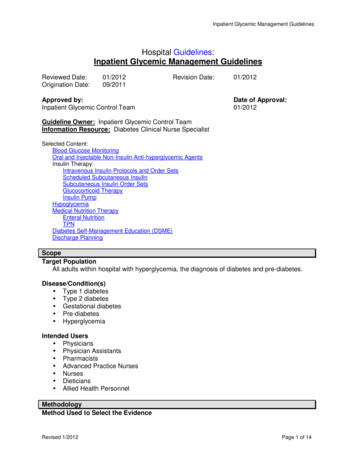

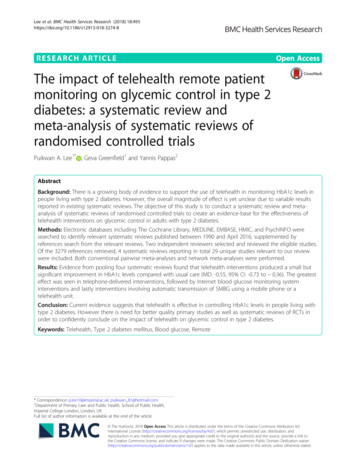
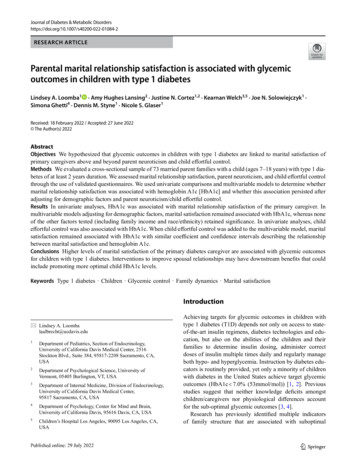




![05[2] Strategy competitors, competitive rivalry .](/img/2/052-strategy-competitors-competitive-rivalry-competitive-behavior-and-competitive-dynamics.jpg)
